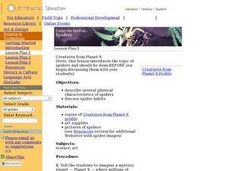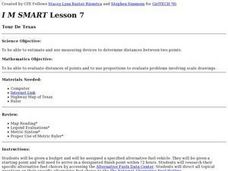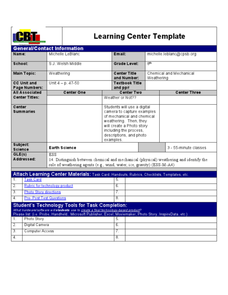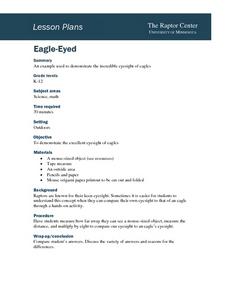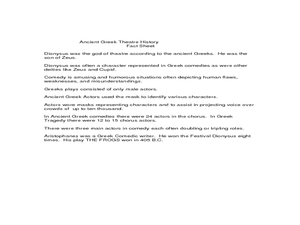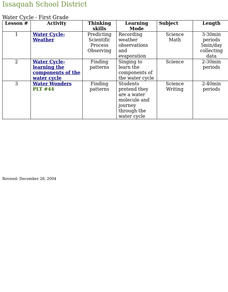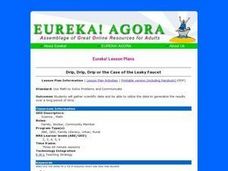Curated OER
Earth From Space
Students watch a series of programs from NASA titled "Earth From Space". After viewing the program, they identify ways NASA is researching the reasons why the Earth is changing. They discuss the various levels of the atmosphere and...
Curated OER
Calculating Your Travel GHGs
Students calculate the amount of greenhouse gases they produce in a given day. Using an equation, they determine the emissions for different sized vehicles and calculate the amount resulting from a family vacation. They create a class...
Curated OER
How Things Fly
Students observe photographs of selected twentieth-century aircraft at the National Air and Space Museum and note differences in the design of aircraft wings, fuselages, and engines.
Curated OER
Spy on a Spider
Learners view slides or live specimens to name and describe the distinguishing features of groups of arthropods, especially spiders and insects. They complete worksheets, observe webs and then search for and record where spiders can be...
Curated OER
Creatures from Planet X: Spiders
Students are given a description of some fascinating animals from "Planet X". They follow the descriptions given to illustrate one of these animals paying careful attention to introduced vocabulary such as 'appendages', 'receptors', and...
Curated OER
Two-Dimensional Drawings from Three-Dimensional Objects
Sixth graders identify and draw two-dimensional representations of a three-dimensional object. Students investigate the views of an object and determine that three views are required (front, one side and the top). Students use these...
Curated OER
Hardwood Lumber
Learners explore hardwood tree products and compare hardwood and softwood trees. They compare and contrast hardwood and softwood leaves and read a flier. After reading they solve equations related to how much feet of board would be...
Curated OER
Vampires: Fact or Fiction?
Middle schoolers predict how many vampires are in the world, based on the legend that, once bitten, each victim becomes a vampire. Extrapolating how many vampires would populate the earth in 30+ weeks, students then compare the total...
Curated OER
Tour De Texas
Young scholars are given a budget and an alternative-fuel vehicle. Using a map of Texas, they are given a starting point and determine how to arrive at their destination within 72 hours. They use the internet to research the...
Curated OER
Paper Packaging Design
Students discuss the relationship between technology and manufacturing. They then use their ideas to construct a model of a paper board carton package. Next they view a PowerPoint presentation to learn about the history of packaging...
Curated OER
Weather... Or Not
Learners observe and discuss the local weather patterns, researching cloud types and weather patterns for cities on the same latitude on the Internet. They record the data for 6-8 weeks on a graph, and make weather predictions for their...
Curated OER
Water Use Around the World
Students compare their water use with other places around the world. They calculate the amount of water they use in a week and discuss how to conserve water. They discover the amount of clean water throughout the world.
Curated OER
Forces on the Human Molecule
Students conduct several simple lab activities to explore the five fundamental load types that can act on structures: tension, compression, shear, bending, and torsion. In this activity, students play the role of molecules in a beam...
Curated OER
Eagle-Eyed
Students study the eyesight of eagles. They discuss raptors and their eyesight and compare it to their own. They measure how far away they can see a small object and its distance. They calculate the eyesight to measure an eagle's...
Curated OER
What Is A Raptor?
Students examine the special characteristics of raptors and discover what separates them from other birds. Students look at different photographs from the Internet or magazines of several different birds and identify the raptors based on...
Curated OER
Dancing with Dionysus
Sixth graders research Ancient Greek culture by acting in a play for the festival of Dionysus. In this Greek culture lesson, 6th graders study an ancient Greek map and the Sarcophagus Dionysus from the Walters Art Museum website....
Curated OER
Primary Level: Earth Day
Middle schoolers research the environment prior to brainstorming a list of ways they can help stop Global Warming. Students then design posters to hang throughout the school and choose at least 1 action to implement in their household.
Curated OER
Anchors Away
Students explore the unique world of the ocean community. They examine cloud formation, habitats and the food chain.
Curated OER
Weather Journal Log
Students discuss the weather each day and log it on a class chart for a month.
Curated OER
Satellite Tracker
Students use satellite tracking software to monitor different satellites. They predict and graph the motion of the space station. They create a 3-D display of its path and share it with the class.
Curated OER
Bald Eagle Population Graphing
Students create graphs to illustrate the bald eagle population. They identify the population of bald eagles in Minnesota and the United States. They create three graphs to represent the population data including a line, bar, and...
Curated OER
Drip, Drip, Drip
Students gather scientific data and be able to utilize the data to generalize results over a long period of time. They use the appropriate tools to measure quanities of liquids and analyze the data to determine the cost of a leaky faucet.
Curated OER
Penguin Paradise
Learners read about penguins and communicate their information in a one paragraph summary. In this penguin writing lesson, students review sentence construction. Learners complete a KWL about penguins and read the book Penguins Through...
Curated OER
Collecting, organizing and comparing data for cellular telephone buying and calculating average, and median price and best deal per cost.
Students research data and develop statistical methods such as mean and median price and make convincing arguments as powerful ways for decision making.




